Menu
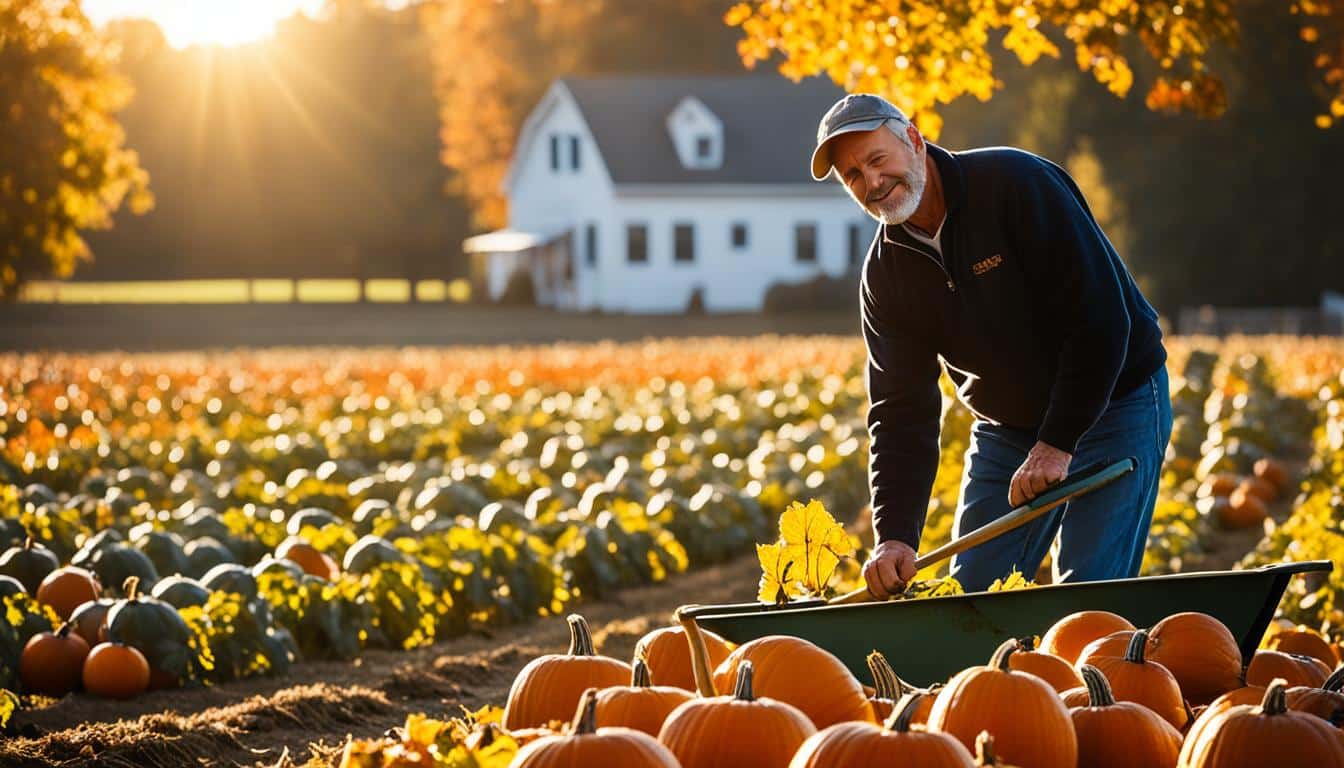
Did you know farm upkeep can increase crop yield by 25%? That’s great news for farmers who want to boost their output and profits. This guide is your go-to for all seasonal farm tasks. It looks into crucial jobs like caring for the soil, animals, and your crops. By planning these tasks well, your farm can stay productive and grow. You’ll learn how to handle any farm work that comes your way with ease.
Running a farm well needs careful planning and a good understanding of seasonal planting, and the harvesting schedule. Tasks change as the seasons do, making it necessary to adjust methods to get the best crop and livestock results. Having a clear plan for each part of the year is key. It helps things run smoothly and keeps the farm healthy and efficient all year round.
Planting and keeping a schedule for harvesting require a lot of organisation and thought. Many farms hire extra help during busy times, such as from June to November, when crops are ready to harvest. It shows how important it is to have skilled workers around for these vital tasks.
There are many different jobs on farms, from growing crops to taking care of animals. This means farm managers have to be quick to adapt to the changing needs of the season. For example, planting season on crop farms might need more people, while livestock farms might need help when animals are giving birth. What’s more, around 2.4 million farm workers in the US are hired every year, including both seasonal and full-time workers.
Farm workers do a lot, from looking after the plants with fertilisers to driving big tractors. It’s worth noting that some farms pay workers more if they harvest a lot, not just by the hour.
Farming can be dangerous, with more accidents than many other jobs. In fact, the agricultural sector had a rate of 19.5 deaths per 100,000 workers in 2021. This is important to remember, and that’s why farms should be very careful and make sure their workers are well-trained and safe.
There are also special jobs available for a short time, like at pick-your-own farms or during festivals. This shows how farming can be both traditional and part of community events. Managing the farm well throughout the year makes sure everything happens smoothly. This not only gets better results but keeps the farm going strong.
Spring is the perfect time to begin important gardening tasks. This includes improving the soil with compost and organic fertilisers. It’s also critical to add topsoil to raised beds. Planning when to plant seeds is key, based on your area’s grow zone. Plus, keeping the garden free of weeds and feeding plants is vital for strong growth. This guide looks at everything needed for a healthy garden and good harvest.
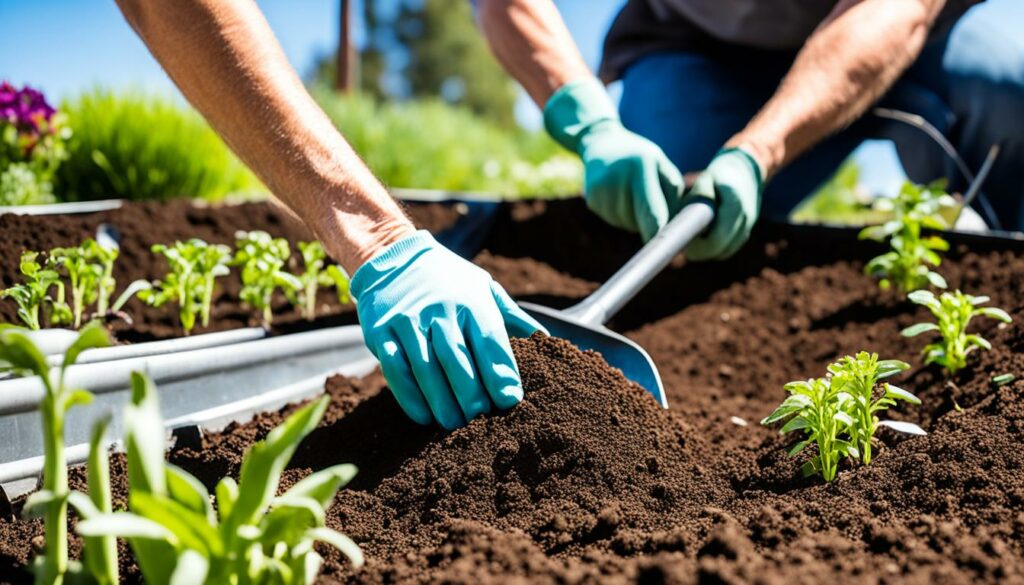
Start your garden work by getting the soil ready. In spring, from March to April, add a 5cm layer of compost or well-rotted manure to your garden beds. Also, mix in some all-purpose fertiliser around trees and shrubs. This ensures they get the nutrients they need. This process makes the soil perfect for planting later.
March and April are great for planting seeds. Choose seeds right for your area and follow the planting schedule. In the early spring, you can plant beets, carrots, radishes, and more. Before moving plants to the garden, place them in a cold frame. This step helps young plants get used to the outdoor conditions.
Weeds must be pulled regularly to keep your garden healthy. Then, add fertiliser to help your plants grow strong. Also, keep the garden moist and protect it from weeds by adding mulch. Mulch with compost or manure to improve the soil too.
Setting a maintenance schedule for your garden is important. With regular weeding and feeding, your garden will thrive. This means a better harvest in the end.
| Task | Description | Tips |
|---|---|---|
| Preparing Soil | Enrich soil with compost and organic fertilisers. | Apply a 5cm layer and fork in lightly. |
| Planting Seeds | Plant based on grow zone recommendations. | Start seeds in March and April; use cold frames for acclimation. |
| Weeding and Fertilising | Regularly weed and apply balanced fertilisers. | Deadhead winter pansies; mulch regularly. |
Spring on a farm is very busy. There are important tasks to be done to keep the animals healthy and the farm productive. The snow is melting, and the ground is perfect for planting. This season also means it’s time to focus on caring for the animals after winter.
During spring, there are more young animals being born. This means we have to take even better care of them. It’s a time when the farm feels alive and there’s lots to do.
In early spring, deworming is key for the animals’ health. Once they’re outside, they can easily pick up parasites. Deworming regularly stops infestations, keeping the herd healthy. A good deworming schedule helps the animals stay well all year.
Shearing alpacas is a big job later in the spring. It helps them stay comfortable and cool. Plus, the wool collected is of top quality, helping the farm financially. Shearing is done with great care, making sure the alpacas are calm.
With lots of baby animals expected, preparing birthing kits is vital. These kits contain everything needed for the birth process. They help make sure the newborns get the right initial care. Being ready with these kits is very important for the farm.
Spring is a season of hard work on the farm. But a good plan for caring for the animals makes everything go smoothly. This includes deworming, shearing alpacas, and getting birthing kits ready. This effort ensures the animals are well and the farm thrives.
Spring marks a time to refresh and reorganise our homes. It neatly fits into the tasks of the farm work checklist. It’s about paying close attention to our pantry, doing annual spring cleanings, and making meals with fresh farm produce.

Looking after the pantry is key to home organisation. We should check our food, so nothing goes to waste. Using labels and grouping foods can make things clearer and less messy. It’s the initial step in completing a full farm work list.
Spring cleaning is more than just dusting. It means giving everything a good clean. We can make it eco-friendly by using natural cleaning stuff. This ensures every corner is cleaned well, making our homes healthier. These cleanings keep our surroundings neat and welcoming.
Creating meals with farm-fresh ingredients helps us appreciate nature more. Cooking items like Dandelion and Wild Onion Focaccia and making natural egg dyes bring joy. It’s a way to celebrate nature’s seasons and hard farm work. This way of cooking brings new tastes to our plates and supports living sustainably.
Doing all these jobs links our home tasks with farm activities. It creates a balanced and holistic approach to spring chores, blending farm and home life beautifully.
In summer, your garden needs a lot of care to stay healthy and lush. Making sure your plants get enough water is a must. They usually need an inch of water every week. This is especially true for young plants, which might need more to grow strong roots.
Early summer is also the time to feed your veggies regularly, every 2-4 weeks. This keeps them healthy and growing well. You should also check your plants every day for pests. Catching and dealing with them early can save your garden from harm.
Dealing with pests involves using treatments you think will work, either organic or chemical. It’s also important to make sure your plants aren’t too close together. This helps them all get enough light and space to flourish.
Weeding consistently is crucial in the summer, as weeds take resources from your plants. Mulching is great for preventing weed growth and keeping the soil moist. This maintains a good environment for all your plants.
Don’t forget pruning and staking. They’re key to making sure your plants grow strong and tall. And, don’t guess when it comes to feeding your plants. A soil test can tell you exactly what they need to thrive.
By late summer, focus on watering your trees and perennials deeply once a month. Also, it’s harvest time for your perennial herbs. After this, stop fertilising your plants, except for those that prefer colder weather, like some veggies.
| Task | Frequency | Details |
|---|---|---|
| Watering | Daily for seedlings; weekly for established plants | Adjust based on plant needs and weather conditions |
| Fertilising | Every 2-4 weeks | Focus on vegetables; stop fertilising later in the season except cool-season plants |
| Pest Monitoring | Daily | Implement pest control measures as needed |
| Weeding and Mulching | Regularly | Prevents resource competition and retains soil moisture |
| Pruning and Staking | Ongoing | Supports plant growth and structure |
| Deep Watering | Once per month | Focus on trees and perennials later in the season |
| Harvesting Herbs | Late Summer | Bundle, cure, and store for later use |
In summer, caring for livestock comes with challenges like keeping them cool and free from pests. Their health depends a lot on the environment they’re in and how well they’re looked after.
It’s very important to always have water available. Animals need lots of water when it’s very hot or cold. Checking and cleaning the water sources helps to keep them safe from dehydration.
Shade is key for protecting animals from too much sun. It also cuts down on parasite problems. Adding fans and good airflow in shelters can make a big difference when it’s hot.
It’s essential to keep up with their health. This means regular vet checks, deworming, and watching for any signs that they are unwell. This helps to stop sicknesses from spreading and keeps them healthy.
If you’re interested in helping with livestock this summer, check out this job:
| Position | Details |
|---|---|
| Job Title | Farm Livestock Worker |
| Hourly Rate | $17.80 |
| Job Type | Full-time |
| Number of Workers Requested | 1 |
| Job Classification | 45-2093.00 – Farmworkers, Farm, Ranch, and Aquacultural Animals |
| Weekly Hours | 40 |
| Work Schedule | 7:00 A.M. – 4:00 P.M. |
| Physical Requirements | Able to lift weights, outdoors work with varying temperatures, specific age criteria |
| Position Duration | May 20, 2024 – September 4, 2024 |
| Pay Rate for Summer | $15.00 per hour |
| Open Positions for Livestock Crew | 2 |
| Scheduled Hours for Livestock Crew | 28 hours per week |
| Application Deadline | March 24, 2024 |
| Hiring Commencement Date | March 1, 2024 |
| Employee Benefits | Monthly crew lunches |
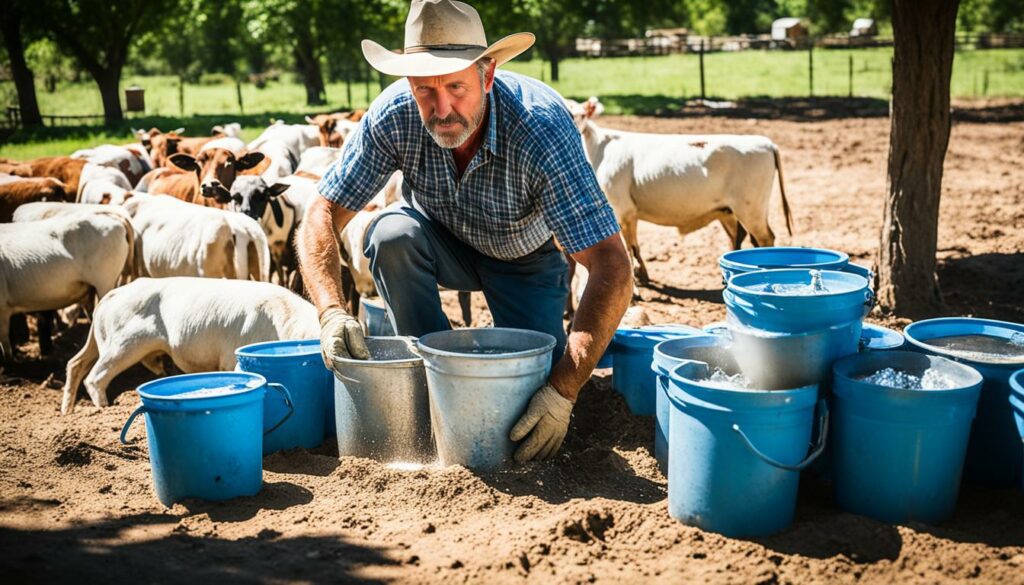
There are also great learning opportunities on the farm. You can learn a lot through daily tasks, walks on the farm, monthly teaching events, and even trips outside the farm.
Following these tips helps me provide the highest level of care for the animals during summer.
The busy summer months on the farm require many important tasks. They help make sure everything runs well later on. This is when many visitors come because of the nice weather.
It’s vital to have a harvesting schedule in summer. This is the best time to gather crops. Planning the harvest well means you get the best crops.
You can keep the farm’s harvest longer by canning, drying, or freezing it. Doing this is also good for the environment, reducing waste. With these methods, you can enjoy your summer harvests all year round.
Looking after your equipment well is crucial. In summer, you need to prepare it for the heat. This might mean switching from fans to coolers or misters.
Regular checks on machines like tractors and mowers are a must. This helps avoid big problems and saves time and money. Good equipment care boosts how much work you can do.
In hot weather, managing water is very important. You need to keep an eye on how much water you use. Making sure animals have enough is vital for their health.
Using water efficiently and checking water levels daily are great ways to save water. This also helps you deal with the summer’s intense heat better.
| Task | Action |
|---|---|
| Harvesting | Follow a meticulous harvesting schedule to maximise yield. |
| Preserving Produce | Utilise canning, drying, or freezing techniques for the year-round supply. |
| Equipment Maintenance | Perform regular checks and servicing on farming equipment. |
| Managing Water Supplies | Implement efficient irrigation and ensure daily water level monitoring. |
As autumn arrives, farmers turn to key tasks to keep their farms running well. They focus on readying the soil for winter. Planting onions now means they’ll be strong enough to survive cold and snow. This makes them a good choice for winter growth.
Garlic is another important crop to plant. It needs to go in the ground before it gets too cold. The soil must be at least 40°F for several weeks to set off a good growth season. For flowers like daffodils and tulips, plant them when nights are cool but not freezing, 6 to 8 weeks before deep cold hits.
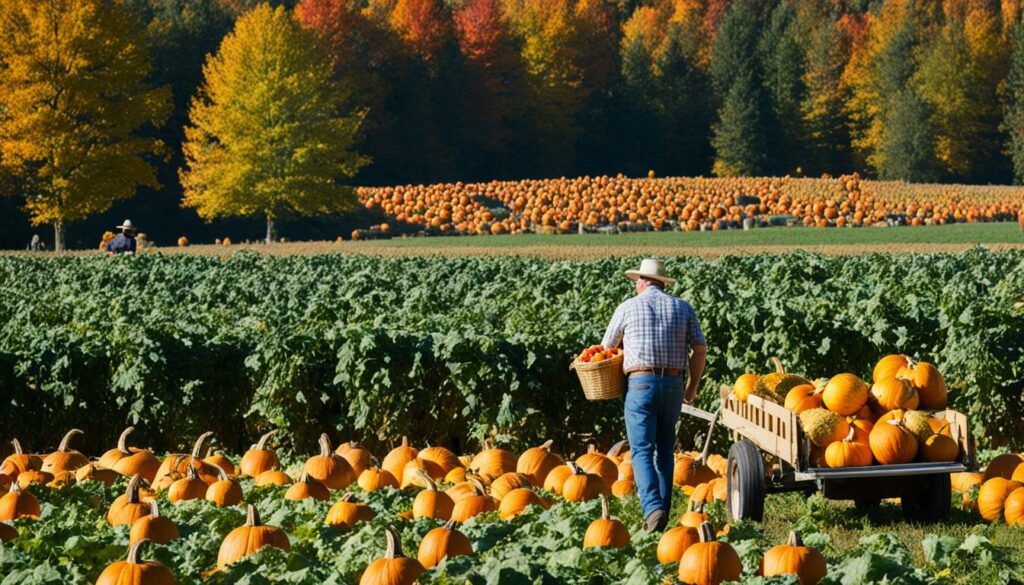
Remove dahlia and begonia tubers before frost to store them safely for winter. It’s key to review the garden’s performance this year. Make notes on what to change or keep for next season.
Chickens shed feathers during autumn, but this is normal and prepares them for winter. It might slow down egg laying for a bit. Start holiday planning now to make the farm work and life less stressful.
Plant cover crops like fava beans to keep your soil rich over winter. These not only protect the earth but also help with a good spring harvest. Even young kids can help with tasks like spreading compost, learning early about taking care of the farm.
By using cover crops and careful planning, the farm keeps growing. These autumn chores, done well, mean the farm will not just get through winter but thrive. This is how farms stay healthy and productive for the long term.
We must get ready for winter to protect our farm. This includes keeping animal shelters warm, storing crops well, and getting equipment ready for the cold. These steps are key for a successful farm in winter.
It’s vital to keep animal shelters warm for the animals’ health. Good insulation keeps the temperature stable and stops animals getting too cold, which could harm them. Be aware that animals need more food to stay warm. Make sure their hooves are looked after and they’re clear of worms. This keeps them healthy through the winter.
We also need to store our crops well for the coming winter. This stops them from going bad and guarantees we’ve got food all winter long. Plant garlic before the ground freezes and lift dahlia and begonia tubers. This is good plant care before winter sets in. Also, treat fruit trees to keep pests away and clean up farm buildings. Cleaning out early creates more room and helps control pests.
Making sure our farm tools can handle the winter is important. Fix fences and clean heating devices before the cold weather hits. Be prepared with enough fuel and food for at least two weeks. This helps if there are any problems getting supplies in the snow. Make sure farm workers have warm clothes. This includes thermal underwear and tough outer layers to keep them warm as they work.
Doing these things will ensure our farm, animals, and crops are ready for winter. By following these steps, we can keep everything strong and healthy through the cold months.
In winter, caring for animals is key. We must shield them from the cold. This includes giving them a warm, dry place to stay. It’s crucial for their health and comfort.
Animals need more food to stay warm in winter. This means they require a special diet. Young calves, for example, need temperatures above 55°F for comfort. Keeping an eye on the weather and feeding them extra is important.
Keeping water fresh and unfrozen is also a must. Water should be checked often. It’s good to insulate the pipes too. Adding a layer of straw inside their shelters helps to keep them warm.
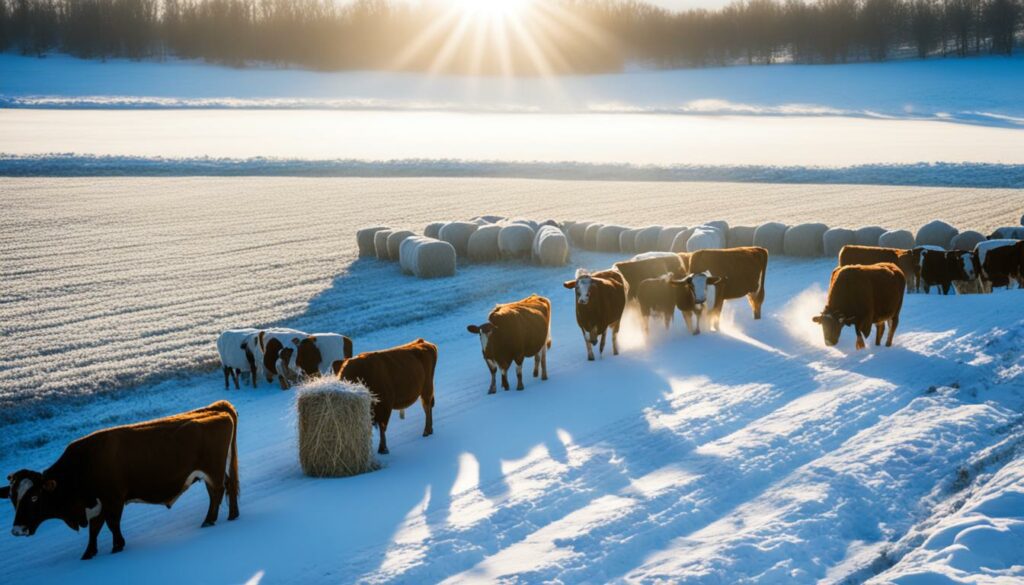
Making pathways safe with snow clearance is vital for the animals. This keeps them and their keepers safe. Renting snow ploughs or using farming services is a good idea. It keeps essential areas open and safe.
Now is a good time to check farm tools and spray equipment. Everything must be ready for the new growing season. This preparation helps fight off pests and illness. These steps ensure a healthy, happy farm this winter.
| Winter Care Practice | Benefit |
|---|---|
| Adjusting Nutritional Intake | Ensures high-energy rations to meet higher metabolic demands |
| Providing Adequate Shelter | Protects livestock from cold winds and precipitation |
| Fresh Bedding and Windbreaks | Improves comfort and insulation for animals |
| Maintaining Water Supplies | Prevents freezing, ensuring a consistent fresh water supply |
In winter, we focus on keeping our homes warm and efficient. Heating systems need regular checks to work well. This makes our homes cosy and saves energy.
Stopping drafts by sealing windows and doors helps keep the heat in. This cuts down on heating bills. Storing enough food for winter prevents shortages if supply chains struggle.
Now, let’s look at specific winter home maintenance tasks:
| Task | Description |
|---|---|
| Heating System Service | Regular maintenance ensures peak efficiency and reliability |
| Seal Drafts | Applying insulation to windows and doors to prevent heat loss |
| Manage Food Stores | Stocking pantries and planning meals to last through winter |
| Bulk Cooking | Preparing and freezing meals for quick, convenient use |
| Gather Firewood | Ensuring ample wood supply for heating or emergencies |
| Monitor Stored Supplies | Regularly checking food and essential supplies for spoilage or depletion |
Regularly doing these home tasks makes winter easier. It helps keep us comfortable and minimises any problems.
Seasonal crop rotation is essential in sustainable farming. It greatly improves soil health and manages pests and diseases. This method involves changing crops every so often, up to an eight-year cycle, to keep the land rich and diverse.
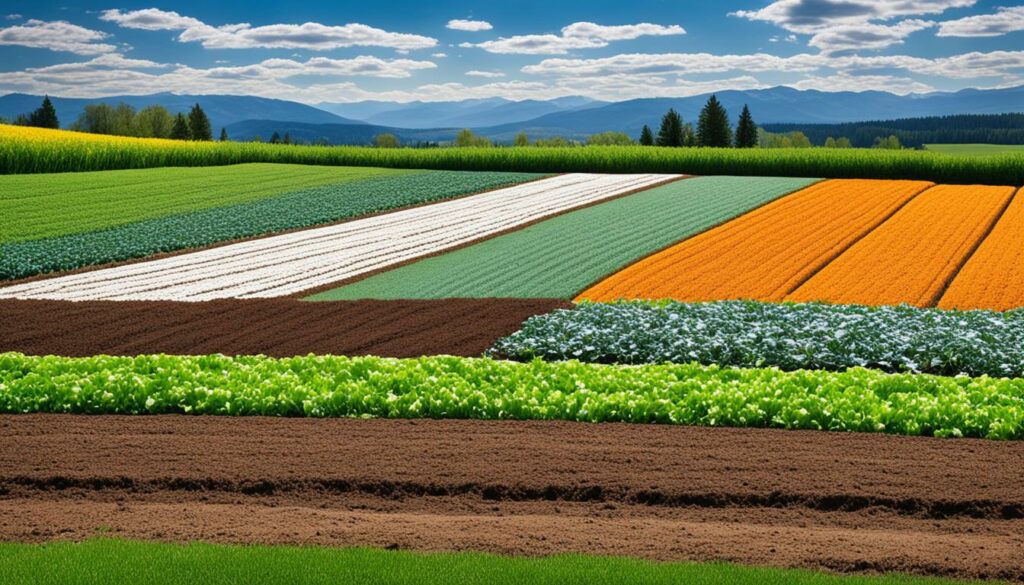
By swapping different plants in a specific order, farmers make the soil much richer. This happens because plants help each other grow better. They leave nutrients in the soil, fight erosion, and even tackle soil compaction.
This method boosts soil fertility and yields. It also makes the farm more resilient against risks. Farmers spend less on watering and fertilisers. This is good for the environment too, as it needs less chemical help.
Crop rotation is also great for fighting pests and diseases. It stops them from taking over. Weeds also find it harder to grow if crops change regularly.
To make crop rotation work, farmers need to know their plants well. They need to pick plants that work together. This takes planning. Skilled farmers, like Jim Gerritsen, use this method to grow the best potatoes without many diseases.
| Benefits of Crop Rotation | Details |
|---|---|
| Soil Fertility | Enhances through nutrient interactions between different plant species. |
| Soil Structure | Reduces compaction, creating optimal conditions for plant growth. |
| Soil Erosion Prevention | Provides barriers through residue left by plants, protecting the soil. |
| Pest and Disease Control | Disrupts life cycles, containing their spread. |
| Weed Management | Alters species mix and reduces weed biomass. |
| Water Use Efficiency | Improves soil water-holding capacity, reducing the need for irrigation. |
To sum up, crop rotation is a smart and proven farming strategy. It benefits the farm long term. It’s all about mixing up crops the right way, knowing what each plant needs.
Having a farm work checklist is key for every farm manager. It helps keep things running smoothly and makes sure every job gets done. The list is vital for staying efficient and effective all year round.
Looking after the farm is essential for it to work well. This means checking on your equipment often to stop it from breaking. It’s also important to oil moving parts and keep fluids topped up. This helps machinery work better and last longer.
Key parts of the farm work checklist include:
All farm types need regular care, whether growing crops or raising animals. Neglecting to look after machinery can lead to performance issues and more breakdowns. Below is a summary of the key tasks needed to keep your farm equipment in top shape.
| Asset | Maintenance Task | Frequency | Remarks |
|---|---|---|---|
| Tractors | Inspect hydraulics, lubricate joints | Weekly | Essential for heavy-duty tasks |
| Harvesters | Check blades, calibrate sensors | Monthly | Crucial during harvest seasons |
| Irrigation Systems | Check sprinklers, clean filters | Bi-monthly | Ensures efficient water distribution |
| Pesticide Dispensers | Test spray nozzles, clean tanks | Seasonally | Important for effective pest control |
Using a detailed farm work checklist makes everything on the farm smoother. It helps ensure the farm stays productive and sustainable. By having clear routines and sticking to them, you set up for success in farming.
Understanding the importance of seasonal farm tasks is key to success. It’s crucial to manage farm work carefully during each season. Doing so ensures a farm runs smoothly and remains productive.
Top farmers know how to look after their crops well. They plan ahead, get the soil ready when the weather allows, and think about new markets. They work hard to make their farms not only do well now but also in the future.
Changing where crops are grown each year, known as crop rotation, is crucial. It keeps the soil healthy, stops diseases, and lowers weeds. This approach helps farms do well economically while guarding the environment.
Furthermore, keeping good records and watching the weather help a lot too. They’re part of the bigger picture — many small tasks that lead to a successful farm. This guide shows that by focusing on every step, from planning to action, farming can be efficient and in tune with nature.
Seasonal farm duties vary by the time of year. They include planting, harvesting, and looking after animals. Home tasks like keeping the pantry organized are important too. Everything is done to make sure the farm is productive throughout the year.
In spring, the soil is readied for planting. This is done by adding compost and organic fertilisers. Raised beds get topped up with fresh topsoil. It’s all to make the ground perfect for seeds and plants to grow well.
Spring care for animals includes deworming them. Alpacas are sheared as it gets warmer. Special birthing kits for newborns are prepared. These tasks ensure the animals are healthy and well taken care of.
In spring, it’s important to tidy the pantry. This is to make sure the stored food is used. Cleaning with natural products is also key. And, making dishes with fresh foods from the garden is a great part of spring.
During summer, gardens need plenty of water and pest control. Crops must be looked after daily. This ensures your garden is healthy and keeps producing food throughout the warm months.
Summer’s key for animals means managing the heat and pests. They need lots of water and shade. Regular health checks are essential. These steps make sure your animals are comfortable and safe during hot spells.
Summer at home is a time of harvesting and storing food. Equipment needs to be kept in good shape. Water usage is high, so managing that well is important. These chores prepare the home for the leaner months ahead.
In autumn, it’s time to gather the last of the crops. Soil is improved with fertilisers and mulch. Equipment checks are carried out. These activities make sure the farm is ready for winter and a strong start next year.
Getting ready for winter means making sure animals and crops are okay. Shelters are checked and made warm. Crops are stored properly to last. This all helps the farm survive the cold months.
Livestock care in winter needs a different feeding plan. Animals get extra bedding and shelter from the wind. Health checks become more frequent. These steps are vital for the well-being of farm animals in the cold.
In winter, home chores focus on staying warm and saving food. Heating systems and drafts are checked. Food supplies are managed carefully. These tasks keep the house comfortable and efficient during the winter.
Crop rotation is key for the health of the soil and plants. It helps with pests too. Moving crops around lets the soil recover its nutrients. This practice leads to better, healthy harvests over time.
A good farm checklist covers everything from fields to animals and the house. It ensures important work is not missed. Farming becomes more organised and efficient with a checklist in hand.